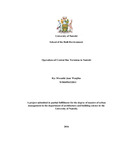| dc.description.abstract | Nairobi is an economic Centre being the capital city of Kenya and the Centre for Nairobi Metropolitan Area (NMA). The City of Nairobi lacks an urban development strategy that would serve as a focus for urban transport development. Public transport operates largely on a de-regulated environment with the informal transport sector contributing to the decay of the public transport service. The public transport sector is regulated by many institutions which are involved in regulation, management and provision of road public transport and operate under different laws. The objective of this research is to study the operational systems for road public transport terminus in the Central Business District (CBD) of Nairobi.
The research methodology involved review of literature, primary and secondary data collection, data analysis, interpretation and recommendation. The study provides policy recommendations for management of operations of road public transport terminus and recommends how to improve the operations of the Central Bus Terminus and other terminus in urban areas. The target population for the study were passenger utilizing the Central Bus Terminus, the public transport operators and transport ―Saving and Credit Cooperative Organization‖ (SACCO‘s) and companies officials. The PSV operators formed the key informants on operations of the terminus. Interviews were also conducted with the relevant government officials to provide insight on the current operational systems and management practices and future plans for public transport in Nairobi.
The primary data was sourced by administering questionnaire, interviewing key informants, photography and observations. Secondary data was collected from the review of published and unpublished materials, government reports, print media and the internet. The Microsoft Excel, Statistical Package for Social Scientist (SPSS), and software‘s like Geographical Information Systems (GIS) were the main computer packages used for data analysis and interpretation. Tables, graphs, maps and text were used for data presentation.
The current modes for public transport in Nairobi have not been able to adequately meet the transport needs of many. Public transport operates on paratransits principle. Passengers take long periods of time waiting for PSV at terminus and even take longer time to get to their final destinations. Routes are not well planned and the Central Bus Terminus is located away from the passenger‘s final destinations. The terminus has not been designed for modal interchange. With no other modes of transport from the terminus passengers are forced to walk for a long time some taking as much as 45 minutes to get to their final destination. There is no comprehensive management framework of public transport and operations at the Central Bus Terminus have been left to the transport SACCO‘s or/and transport companies and other cartels. | en_US |



